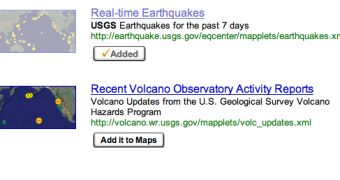Since Google introduced the Mapplets technology into the web-based mapping tool, a lot of users created their own maps with different purposes. Either they were showing information about floods or traffic, they were all very useful and kept the main technology - Google Maps in spotlights. Today, Scott Haefner and Dina Venezky, Geologists, U.S. Geological Survey, two employees working at the US Geological Survey, posted a message on the official Google blog to present their recently created mapplets. If you didn't know, the USGS is an organization that tracks the evolution of the nature, including earthquake, volcanoes eruptions or any other natural hazard.
Because of that, the employees wanted to build some useful mapplets that would allow the consumers to view or track the evolution of the earthquakes and volcanoes straight from Google Maps. The two projects, Earthquake Mapplet and Volcano Mapplet, are available for free and can be added to Google Maps by clicking HERE or HERE.
"The Earthquake Mapplet plots the past week of earthquakes around the world, showing the location, time and magnitude. Each earthquake includes a link to the USGS earthquake website for more information, including additional parameters, background and other content such as Google Earth KMLs, ShakeMaps (shaking intensity maps) and "Did You Feel It?" maps," the two representatives wrote in the description of the first mapplet.
The second project is even more interesting because it tracks the US volcanoes activity and provides real time information about them. "The Volcano Mapplet displays the latest U.S. volcano updates, showing the current level of both ground-based and aviation hazards. Clicking on an alert icon provides a summary of the volcano update along with a link to the USGS Volcano Hazards Program website for additional details and images."
If you want to create your own Google map, you should go over to Google Maps and click on the My Maps tab available in the left part of the page.

 14 DAY TRIAL //
14 DAY TRIAL //